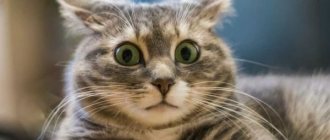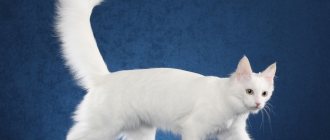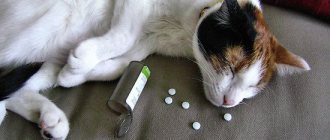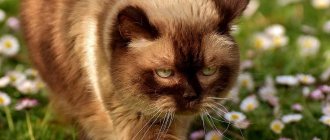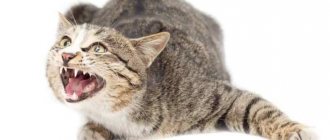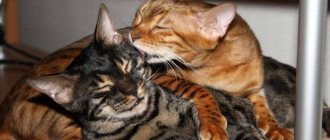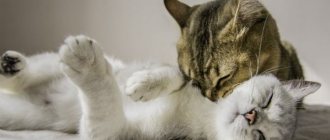Friendly, playful and cuddly are just a few words that describe the personality of the domestic shorthair cat. They are furry friends who will be a welcome addition to both busy and relaxed families.
It may seem hard to believe that your loving domestic cat is distantly related to the cats of the wild. The domestic cat has been part of the household for over 4,000 years. The ancient Egyptians loved them, and since that time many people have been buried with their cats. Their size and coloring of a domestic cat depends on the subspecies and breed. It also depends on the location and type of diet offered.
Briefly about the domestic shorthair cat
Weight range:
- Men: > 7 kg.
- Women: >5.5 kg.
Eye color:
- Green, blue, gold, walnut
© shutterstock
Expectations :
- Lifespan: 15-20 years
- Social/Attention Needs: Moderate
- Shedding tendency: low
Wool:
- Length: Short
- Characteristics: Smooth, soft
- Colors: Various
- Less allergenic: No
- Overall care needs: Low
Description
The domestic cat usually has a long and lean body. They have very long tails. You may find some that are quite round due to being overfed by their human owners. They have small skulls and very tiny teeth. These are fast and agile animals that can climb and jump.
They can have sharp nails, so many owners have those who live indoors have their nails trimmed by a veterinarian, but this is wrong and goes against their nature. Possessing very good eyesight and hearing, the domestic cat easily recognizes what is happening around it. When they feel afraid, they very often retreat.
Habitat and distribution of domestic cats
A domestic cat can live anywhere. They do well in any climate. Some are indoor cats, while others live outdoors. There are many owners who allow them to come and go at their leisure. These animals have the freedom to roam and explore.
However, not all domestic cats have a home. There is a problem in many communities that a large number of them move freely. They search for food and find various places that can be used as shelter. The risk of disease among such groups is very high, and therefore many of them are concerned about it.
What to feed?
Cats have well-developed taste buds on their tongue. They distinguish between sour, salty, bitter and sweet.
The food tract of cats is accustomed to meat. Sharp fangs crush it, and the tubercles on the sides of the tongue help separate the pulp from the bones. The meat menu needs to be diversified with other high protein foods - fish, eggs, dairy products. Carbohydrates are needed in small quantities - cereals, vegetables, bread. Eating too much food leads to obesity, and a normal human diet is harmful to a cat. Periodically, the cat's stomach is cleared of undigested residues. To do this, the mustache “snacks” on grass, leaves, and at home – on house plants, for example, aloe. Sometimes the “hunter” eats soil, which indicates a lack of microelements. They are always included in cat food.
Behavior of domestic cats
Many people say that a domestic cat has the life we all dream about. Someone is waiting for them, an opportunity to be alone and relax. Most domestic cats are very independent and spend a lot of time lounging in the sun or napping. They are very playful as kittens, but as they get older the need for them seems to disappear. They purr often, and their owners mistake this sound for them to be very relaxed.
© shutterstock
What does scratching mean?
In general, scratching in cats is often regarded as aggressive behavior. But this does not always indicate the bad character of the animal. If the kitten is small, then this is quite acceptable. After all, this is how he understands the world. Yet these “cute creatures” are predators by nature.
But sometimes even adult cats strive to bite or scold their owner. In this case, your pet has a very highly developed hunting instinct . He perceives your moving legs and arms as “prey.” To satisfy the desire of the “hunter”, purchase special toys for him.
Sometimes curtains and furniture suffer from scratching. Cats don't do this out of spite. When scratched on the surface, they remove old nail scales. And they also keep the paw muscles toned. Damaged furniture and curtains are not pampering for them, but a necessity. Therefore, you should think about buying a scratching post.
Diet and feeding habits of domestic cats
The domestic cat is the only member of the cat family that does not survive solely on the meat it hunts. However, the instinct is there. Many pet cat owners have found that they catch mice or birds. In fact, many people keep their own pet cats to reduce the likelihood of them encountering rodents.
A cat's diet can vary significantly. Many of the products offered contain some type of meat. There are a variety of wet and dry cat foods. Owners often find that they need to try different products before they get one that their cat likes. They can be very picky, turn up their noses and not touch what they don't like.
How to choose the perfect cat
It will not be possible to choose an ideal, since each owner has his own idea of the ideal. For some, the most important thing is a kitten’s playfulness, for others – complaisance and learning ability.
The most important advice that can be given to a future pet owner is quite simple. You need to follow your inner instincts and choose a kitten that you like. Even if you make a mistake with your choice, your character can always be corrected by upbringing and showing care and love for the animal.
Cats of different breeds
The director of the pet salon, Natalya Khabarova, will talk about how to determine temperament and understand what kind of character a particular cat may have.
Reproduction of domestic cats
Mating can occur in a domestic cat at any time of the year. Females will give birth 60-67 days after mating. There can be up to 5 kittens in a litter. The young are weaned at approximately 6 weeks of age. A typical female can have up to 3 litters of kittens per year.
The lifespan of a domestic cat can vary significantly. Some of them only live a couple of years due to injury or illness. Those with loving owners who take care of their needs can easily live 15 years. However, a cat's genetic profile often determines quality of life. Many of them tend to suffer from illnesses including arthritis, hearing loss or vision loss.
Features of the visual analyzer
These animals have binocular vision, their eyes are large and do not blink. They are so capable of refracting streams of light emanating from various objects and things in the dark. As already mentioned, cat eyes hardly blink. In order to cleanse the eyes of foreign particles and protect them from damage, cats have a special membrane.
Their analyzers are designed in such a way that the fields of vision overlap each other. The result is a stereoscopic image (the scope of vision of one cat's eye is 200 - 205?). These animals calculate the distance to the desired object with amazing accuracy.
Previously, there was a belief that these pets have black and white vision. But this is a misconception and nothing more. Special studies have been carried out, during which it is precisely established that they distinguish colors. Cats are known to have excellent eyesight. However, they see stationary objects or things that are close to them much worse than everything else.
In bright sunlight, due to the strong constriction of the pupil, it is also difficult for them to navigate, while in twilight the pupil becomes completely round, and the cat can see everything it needs. But there is no need to be mistaken.
In complete, absolute darkness, these animals still become helpless and cannot see. Since the eyeball is in constant tone, it is moistened every second with tears, which are produced in huge quantities in cats.
It has long been no secret that cats sleep most of their lives, 14-16 hours a day. By studying their sleep, scientists found that some parts of the brain sleep, while others remain active. It turns out that the brains of these wonderful pets never turn off completely, even during sleep.
They also have such a biological feature as a highly developed sense of touch. The cat's body is literally covered with special tactile places: whiskers, eyebrows, carpal hairs of the front paws. For example, with the help of its whiskers, a cat determines with what speed and force it should jump, and tufts of hair on the wrists of its paws help it not to bump into objects.
Cats have quite mobile ears. They hear in the range of up to 60 thousand hertz, and communicate with kittens at the ultrasonic level. Their balance organ is also located in the inner ear. When falling, she is able to group herself and land on all four paws.
Cats, like humans, perceive four basic tastes: salty, sweet, sour and bitter, but unlike humans, they do not particularly like sweets.
Cats have an excellent sense of smell. Some fragrances can influence their ethology. For example, a cat begins a flehmen reaction to the urine of a female in heat. The vast majority of cats respond to catnip with the same reaction.
The unique substance of catwort causes a state similar to stupefaction in 50% of cats: they meow, rub against the source of the smell, and roll on the floor. This grass is often stuffed into cat toys. Even children have heard about this plant, which is especially revered by cats.
This is cat root (mauna, or, more simply, valerian). If a cat finds this plant, it is no longer able to move away from it. There is no scientific explanation for this. In addition to attractive smells, there are a number of ones that repel cats.
The owners generously rub the surfaces from which they need to ward off the pet with regular onions. There is a rather aromatic shrub called rue. It drives away cats and sometimes even irritates their skin, causing a rash. Vinegar is the sworn enemy of cats. Its specific smell scares and drives them away. They also cannot tolerate garlic.
It is very difficult to determine the age of these pets, because the grinding of teeth, changes in coat color and in the lens of the eye occur differently than in dogs. In general, a cat's age ranges from 10 to 12 years. With good care and care, they can live 20 years. Take care of your pets. They are very defenseless, fragile and gentle creatures.
Saving Domestic Cats
You may be surprised to know that the domestic cat is one of the most popular pets in Russia. They are more common than dogs because they are easier to care for. Many owners love their cat's loyalty and the fact that she makes little noise. There are currently no conservation efforts underway for this feline species.
In fact, there are many organizations that continue to promote the importance of neutering domestic cats. There are so many of them who end up lost or end up in shelters because there is no home for them.
Hairless
Don Sphynx
Don Sphynxes are affectionate, non-aggressive, and playful. They have somewhat dog-like habits, while remaining unobtrusive and tactful.
Breed characteristics
- Hairless cover;
- medium sized body;
- big ears; expressive almond-shaped eyes;
- pronounced eyebrows and cheekbones;
- long graceful paws.
Canadian Sphynx
The Canadian Sphynx is the first recognized breed of hairless cat. All Sphynx cats are characterized by increased body temperature and the ability to tan. They become very attached to their owners. These creatures need constant communication. Canadians are very smart and learn new things easily. They are friendly with absolutely everyone and get along great with children.
Breed characteristics
- Hairless cover;
- dense muscular body;
- folds on the skin;
- the forelimbs are shorter than the hind limbs;
- large wide ears with rounded tips.
Petersburg Sphinx
Of all the types of sphinxes, the Petersburg, or Peterbald, is the most graceful. He looks more like an oriental cat than other sphinxes. The Peterbald is a companion cat; he does not like to walk on his own. Thanks to the presence of Siamese-Oriental cat breeds in the pedigree, the Peterbald is very active. His character retains all the traits characteristic of the ancestors of other breeds: lack of aggression, sociability and love.
Breed characteristics
- Hairless cover;
- thin, invisible undercoat;
- small wedge-shaped head with huge ears;
- blue or green eyes;
- long nose, straight profile.

